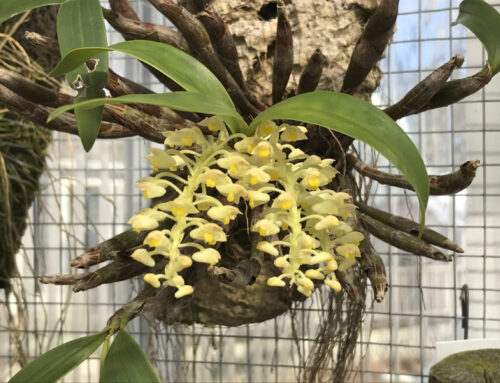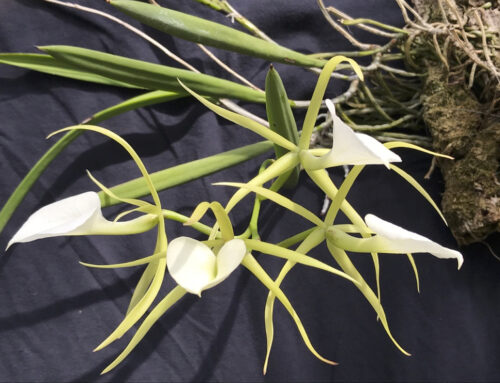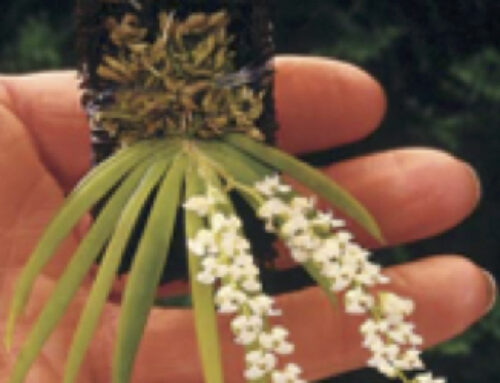By Susan Jones
Like people, orchids, especially those that prefer cooler, shadier environments, can suffer from heat stress during the hot summer months. The midday sun is intense, especially during the summer, and the high temperatures that bright sunshine brings can burn your orchids quickly, especially the more sensitive types such as phalaenopsis, pleurothallids, paphiopedilums and miltonias.
Heat stress is a condition that occurs in orchids and other plants when excessive heat causes an imbalance in transpiration, the process by which moisture evaporates from the plant’s tissues. When that rate of evaporation exceeds the pace at which moisture is being replaced through water taken up by the orchid’s roots, the plant becomes dehydrated — leaves soft and wilted, pseudobulbs wrinkled and ridged. The instinctive response in this situation is to overwater the orchid to correct the dehydration. This can instead make matters worse by rotting the plant’s root system, further hampering its ability to take in much-needed hydration. The roots can only absorb so much water at one time. In addition to watering, control of heat and humidity play a significant role in the prevention and management of heat stress.
Placing a mounted plant in an empty clay pot can help retain moisture around roots. The microclimate of higher humidity helps prevent heat stress and aids stressed plants in recovering.
Signs of Heat Stress
These symptoms may appear singly, even in otherwise fairly healthy orchids. When they appear in combination, however, it is usually an indication of heat stress or an underlying problem (such as root loss) that has lead to heat stress.
- Yellowing of Plants and Leaves: Too much light causes a plant’s chlorophyll to deteriorate, which can turn your orchid an anemic yellow-green, and eventually cause premature loss of leaves. Most healthy orchids receiving appropriate light levels will be a robust light green.
- Withered Leaves: The culprit, especially in summer weather, can be overheating. If your plant’s leaves feel warm to the touch, they could be getting too much light, and need increased air circulation and shading, or a move to a more protected area.
- Sunburn: Initial signs of sunburn, as in humans, appear as a reddish-purple tint or freckles on leaves and pseudobulbs. In advanced stages, leaf tips and roots may brown, flowers drop, buds blast or flower spikes fail altogether.
- Shriveled Pseudobulbs: Your orchid’s pseudobulbs serve as its water-storage organs, so shriveled pseudobulbs indicate a dehydrated orchid – it is in a stressed state, having used up its moisture reserves.
- Leathery Leaves: This goes beyond mere wilting, and occurs in the advanced stages of heat stress, indicating severe desiccation and possible damage on the cellular level. Depending on how long the condition has persisted, the type of orchid and its overall health aside from the leaf damage, it may or may not recover once its leaves are parched.
Mounted orchids are particularly sensitive to higher temperatures and require additional water and humidity during hot weather. This Cattleya hybrid exhibits the yellowing leaves and wrinkled pseudobulbs typical of heat-stressed plants.
Prevention
Your orchids need lots of attention during the summer months, especially on hot days. With higher temperatures, orchids require more frequent watering to prevent dehydration. High temperatures quickly dry out mounted orchids, those in baskets and even potted plants.
Maintaining the balance between keeping orchids sufficiently hydrated and over-watering can be a challenge. A simple rule of thumb is that an orchid’s need for water increases and decreases with the ambient temperature, so water thoroughly and more frequently during higher temperatures. Most mounted plants and those in baskets, especially vandaceous orchids and other genera grown with little or no media, will benefit from daily watering in warmer weather.
In addition, keep humidity high and air movement continuous, as both of these factors help plants keep their cool on hot days. Adding a fan to the growing area, or locating your orchids where they receive the caress of summer’s breezes, as well as spacing your plants to allow for sufficient air circulation between orchids, can make a big difference in their environment and overall health. This will also help to keep rots from fungi and bacteria at bay.
The benefits from misting orchids during hot weather do not have much sustained effect, so unless one has a misting system in place to maintain that added humidity throughout the day, it is probably not useful to your plants. When watering or misting, always be certain that plants have ample time to dry before night falls, so as to discourage bacterial and fungal growth.
When moving orchids outside for the season, start them out in a shaded spot and gradually increase their exposure to sunlight to acclimate them to the higher outdoor light levels. Make sure to protect them from the strongest sunlight as midday summer sun has more intense UV rays that can burn tender plants. Check the amount of exposure your plants receive at different times during the day as the sun moves, and throughout the year as the earth’s orbit around the sun makes its gradual seasonal changes, which in turn changes the angle of the exposure your plants receive.
For greenhouse growers, consider using shade cloth for added protection during the summer months. Windowsill growers may want to add a sheer curtain during the summertime to keep sunlight reflected by the window glass from causing sunburn.
Finally, always have someone care for your orchids while you are away on summer vacation.
Treatment
Once an orchid has suffered the effects of heat stress, it may take a long time to rebound. Apply fertilizers sparingly, using a weak solution, and flush the growing medium with clean water between applications of fertilizer, as the salts in fertilizers are difficult for dehydrated plants to assimilate, and a regular dose may further burn the plant. Be especially alert for pests on distressed orchids – insects and viruses are more likely to attack weakened plants.
—
References
- Dodge, Vivian M. 2003. “Sun Protection.” Vivi’s Orchid Corner. 8(6).
- __. 2000. “Tips for August.” Vivi’s Orchid Corner. 5(7).
- Withner, Carl L. 1997. “Good Orchid Growing or the Concept of Stress on Plants.” Orchid Society of Nova Scotia newsletter, May.
Susan Jones was the editor of Awards Quarterly and assistant editor of Orchids. American Orchid Society, 16700 AOS Lane, Delray Beach, Florida 33446
All reuse must contain the following:
Reprinted from the JULY 2004 issue of Orchids — The Bulletin of the American Orchid Society. Copyright American Orchid Society — aos.org






